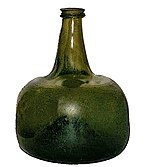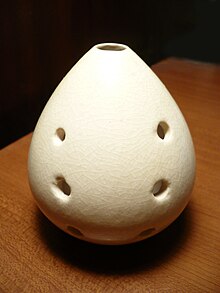A vessel flute is a type of flute with a body which acts as a Helmholtz resonator. The body is vessel-shaped, not tube- or cone-shaped; that is, the far end is closed.
Most flutes have cylindrical or conical bore (examples: concert flute, shawm). Vessel flutes have more spherical hollow bodies.
The air in the body of a vessel flute resonates as one, with air moving alternately in and out of the vessel, and the pressure inside the vessel increasing and decreasing. This is unlike the resonance of a tube or cone of air, where air moves back and forth along the tube, with pressure increasing in part of the tube while it decreases in another.
Blowing across the opening of empty bottle produces a basic edge-blown vessel flute. Multi-note vessel flutes include the ocarina.[1]
A Helmholtz resonator is unusually selective in amplifying only one frequency. Most resonators also amplify more overtones.[2] As a result, vessel flutes have a distinctive overtoneless sound.
- ^ For a linguistic analysis of the possible origins of the word ocarina:
Perono Cacciafoco, Francesco (2019). "A Prehistoric 'Little Goose': a New Etymology for the Word ocarina". Analele Universităţii din Craiova. Ştiinţe Filologice. Lingvistică. 41 (1–2): 356–369. ISSN 1224-5712. - ^ Fundamentals of Musical Acoustics. Arthur H. Benade pp.473–476




